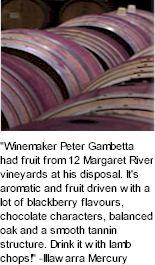


Sunk in the late 1800s in what is now known as Ringbolt Bay, located on the southern tip of the Margaret River wine region, adjacent to Cape Leeuwin. It is at Ringbolt Bay where the Southern and Indian Oceans merge and their invigorating waters lap at the edge of the Margaret River wine region.

Around 1920, the WA and UK governments established a Group Settlement Scheme for people seeking a new and better life in unchartered lands in Western Australia. The scheme was set up to establish a dairy farming industry and encourage people to make the journey to Western Australia through land grants in the Margaret River region. Faced with the prospect of living in extremely tough conditions, most of the settlers despaired and moved away – but a few remained and were the forefathers of the Margaret River wine region.
Vineyards were first planted in Margaret River in the 19th century but disappeared in the early 20th century as the markets looked elsewhere. The development of Margaret River as it exists today was largely due to Dr John S Gladstones. In 1965 Dr Gladstones emphasised the region's suitability on his report "The Climate and Soils of Southern WA in relation to Vine Growing", in which he said: “It has distinct advantages over both those areas [Manjimup and Mt. Barker], and indeed over all other Australian vine districts with comparable temperature summations…” and Margaret River was reborn.
Defined by the oceans, the Margaret River region enjoys a temperate, maritime climate with high winter rainfall and pristine, robust sea breezes to cool the precious fruit – wonderful conditions for growing superior Cabernet Sauvignon. The name Ringbolt honours the heritage of the Margaret River wine region. “Hold them fast, work them hard, build a heritage" pays homage to the beginnings of the Margaret River wine region and the colonial hardship which has made it what it is today. It reminds us of the countless years of hardship endured by the settlers and their strength, tenacity and commitment to making a go of the potential opportunity afforded to them.
Winemaker Peter Gambetta first worked with Margaret River fruit in 1986. He was determined to make wine there after sharing a bottle of Margaret River wine and recognising the potential of the region to produce something special. "That first vintage gave me an insight into the intensity and outstanding varietal flavour of Margaret River Cabernet" said Peter. It was the beginning of his association with Margaret River and his appreciation of its wines. That vintage was doubly memorable as he also met another winemaker who eventually became his wife.